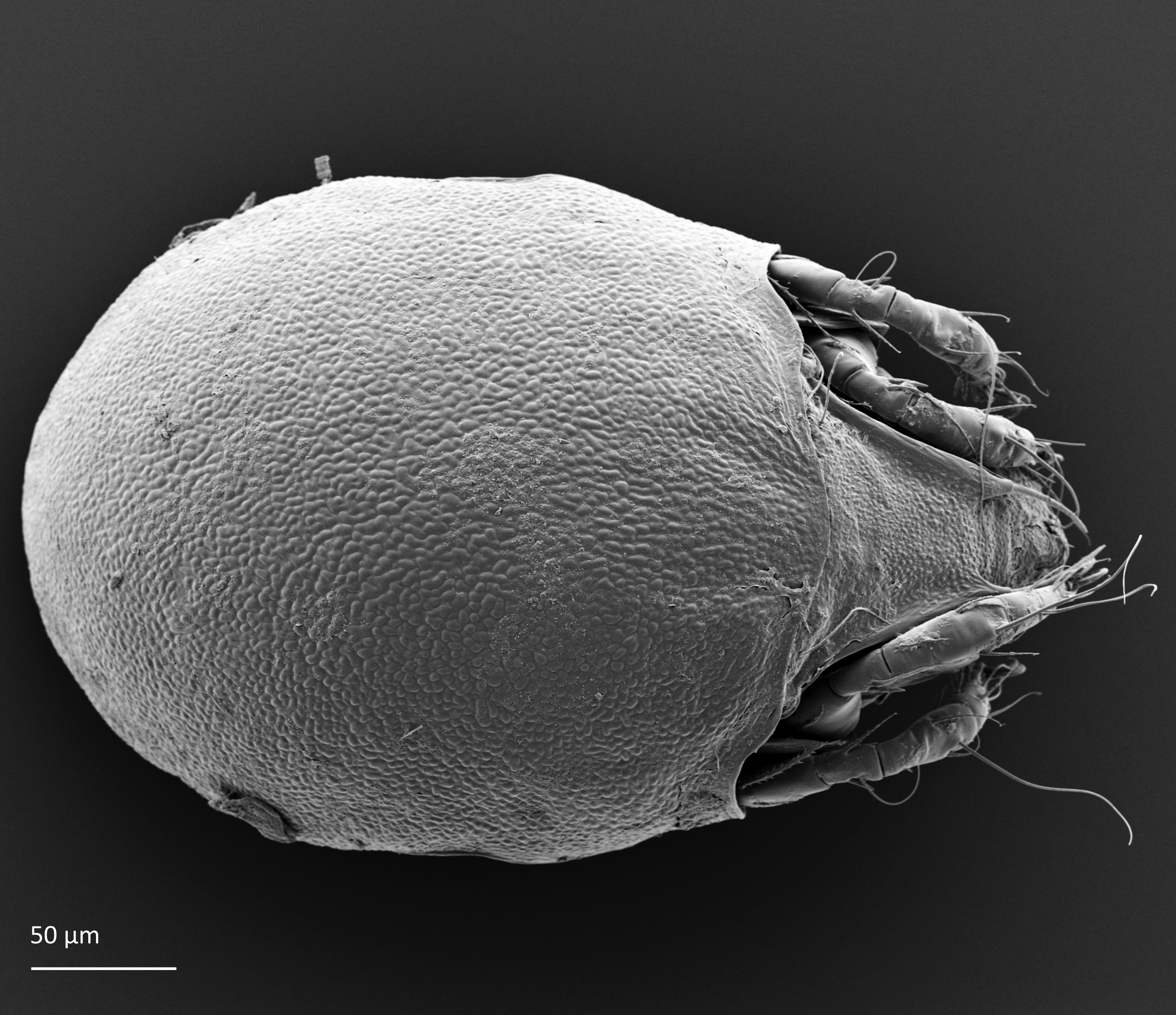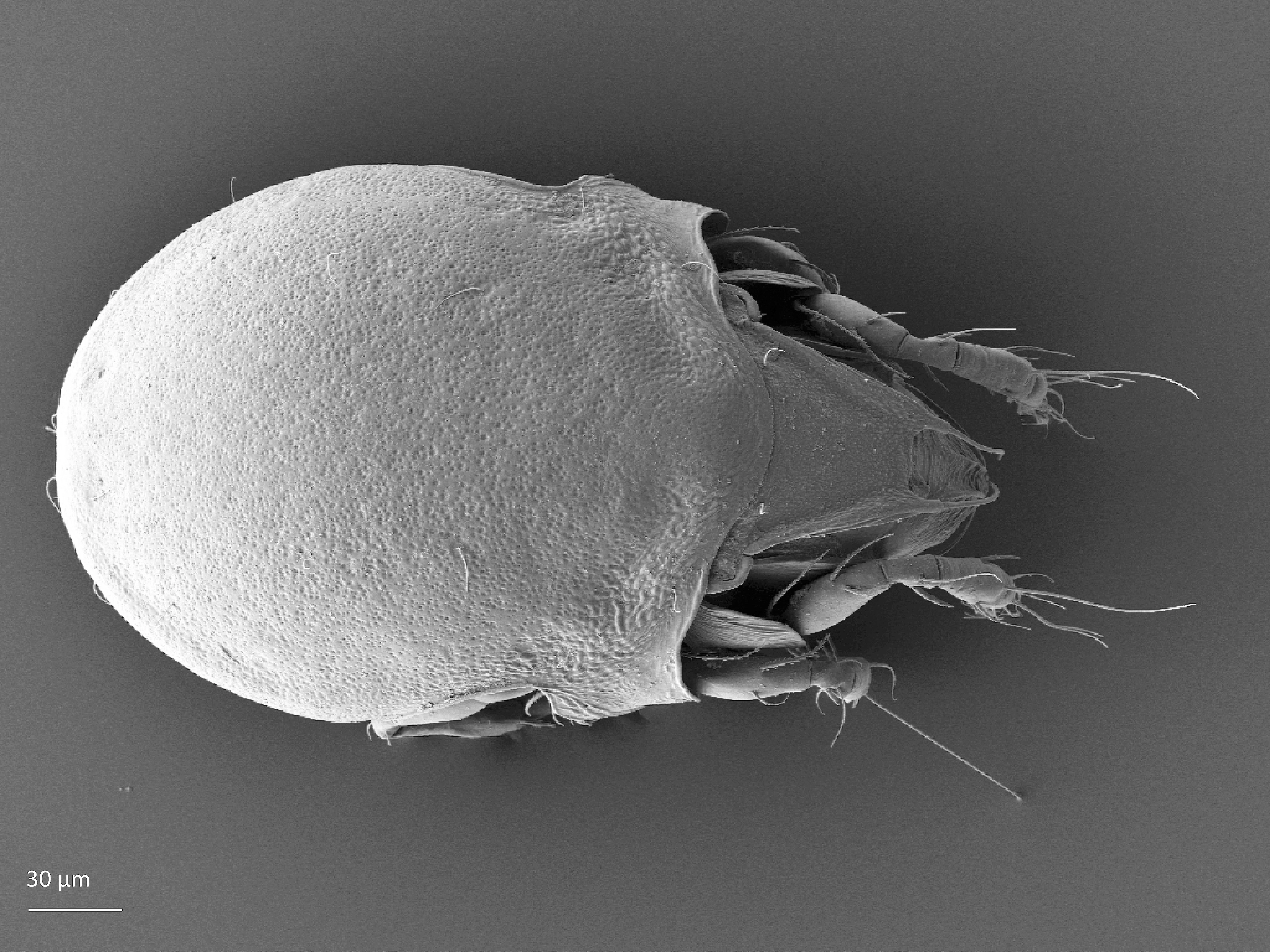Limnozetes rugosus
Limnozetes rugosus is a common representative of the genus Limnozetes, often found together with an even more common species, Limnozetes ciliatus. Like all Limnozetes species, it is aquatic and restricted to peatlands. In Norway it was discovered quite recently.
- Innhold
- Description
- Look-alikes
- Biology
- Ecology
Description
Adult: The length of the body is on average 390 µm and the width is 251 µm. The body is stocky and dark brown. The notogaster is convex and the body surface is covered with rounded microtubercles. The pteromorphs are wider than long and the body behind the pteromorphs is not significantly narrowed (Fig. 1), while they are significantly narrowed e.g., in Limnozetes ciliatus (Schrank, 1803). Notogaster usually has 10 pairs of setae, but sometimes 11 pairs are present, all short and thin. The prodorsum has a pair of narrow lamellae with rather short cusp, and the translamella is incomplete. The bothridial seta is setiform and smooth (Weigmann 2006, Seniczak and Seniczak 2010).
Juvenile stages: Larva: body length 215 µm, width 147 µm. Protonymph: body length 257 µm, width 175 µm. Deutonymph: body length 304 µm, width 211 µm. Tritonymph: body length 350 µm, width 257 µm. The color is yellow brown. Juveniles have plicate cuticle (Fig. 2). The prodorsal lamellar and interlamellar setae are rather long, the rostral seta is distinctly shorter. The bothridial setae are long and setiform, but often broken. Setae on the gastronotum are short and smooth, but some of these setae are longer (Seniczak and Seniczak 2010).
Fig. 1. Dorsal view of Limnozetes rugosus, adult.
Fig. 3. Dorsal view of Limnozetes rugosus, juvenile (tritonymph).
Look-alikes
Limnozetes rugosus is similar to a common representative of this genus, Limnozetes ciliatus, but the two species differ especially as juvenile forms. The adult of Limnozetes rugosus is stockier in dorsal aspect and convex in lateral aspect. The body behind the pteromorphs is not significantly narrowed, while in Limnozetes ciliatus it is narrowed. In Limnozetes rugosus the notogaster surface is covered with rounded microtubercles, while in Limnozetes ciliatus it is smooth and finely punctuated. The juveniles of Limnozetes rugosus are rather stocky, have plicate cuticle and thin gastronotal setae, while those of Limnozetes ciliatus are boat-shaped, with rather thick and stiff peripheral setae on the gastronotum (Seniczak and Seniczak 2009, 2010).
Biology
The species is parthenogenetic, meaning that females are produced from unfertilized eggs. Its feeding preferences and time of development are unknown.
Fig. 2. Dorsal view of Limnozetes rugosus, juvenile (tritonymph).
Ecology
Limnozetes rugosus usually occurs together with other Limnozetes species but is outnumbered by them. Only in Finse it was found alone, very abundant and represented by all developmental instars. The density was ca 16 thousand specimens per 1 m2. Based on Finse material all developmental instars were described for the first time (Seniczak and Seniczak 2010). The highest percentage of juveniles was observed in the autumn (Seniczak 2011).
Distribution
Limnozetes rugosus is distributed in northern Europe (Subías 2004).
Habitat
The species lives in Sphagnum-dominated peatlands and is confined to aquatic, acidic microhabitats.
Findings in Norway
It has so far (as of 2023) only been found in Vestland (Seniczak et al. 2010, 2020), Trøndelag, and Nordland (A. Seniczak, pers. comm. 2023).
References
Seniczak A (2011). Mites (Acari) of the Shores of Forest Lakes and Ponds in Northern Poland, With Species Analysis of Oribatida. Wydawnictwa UTP, Bydgoszcz, 1–231.
Seniczak A and Seniczak S (2010). Morphological differentiation of Limnozetes Hull, 1916 (Acari: Oribatida: Limnozetidae) in the light of ontogenetic studies. Belgian Journal of Zoology 140(1), 40–58.
Seniczak A, Seniczak S, Iturrondobeitia JC, Solhøy T and Flatberg KI (2020) Diverse Sphagnum mosses support rich moss mite communities (Acari, Oribatida) in mires of western Norway, Wetlands, 40, 1339–1351. doi.org/10.1007/s13157-019-01236-w
Seniczak A, Solhøy T, Seniczak S and Riva-Caballero A (2010). Species composition and abundance of the oribatid fauna (Acari, Oribatida) at two lakes in the Fløyen area, Bergen, Norway. Biological Letters, 47(1), 11–19. doi.org/10.2478/v10120-009-0014-0
Seniczak S and Seniczak A (2009). Morphology of some species of Limnozetes Hull, 1916 (Acari: Oribatida: Limnozetidae), and keys to the larvae and nymphs. Annales Zoologici, 59(3), 387–396. doi.org/10.3161/000345409X476459
Subías LS (2004). Listado sistemático, sinonímico y biogeográfico de los ácaros oribátidos (Acariformes, Oribatida) del mundo (excepto fósiles). Graellsia 60 (número extraordinario), 3–305.
Weigmann G (2006). Hornmilben (Oribatida). Die Tierwelt Deutschlands. 520 pp. Vol. 76, Goecke and Evers, Keltern.




